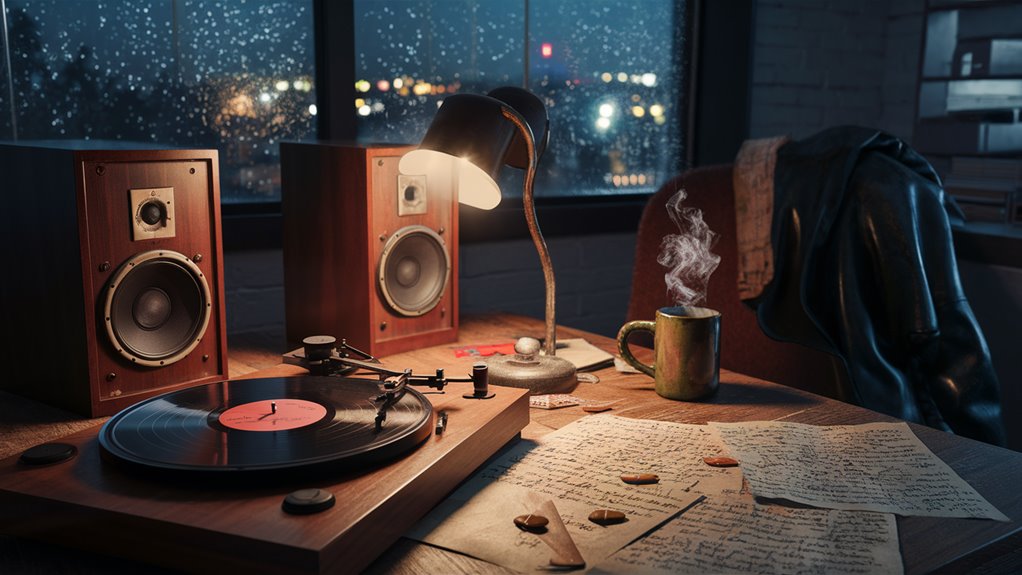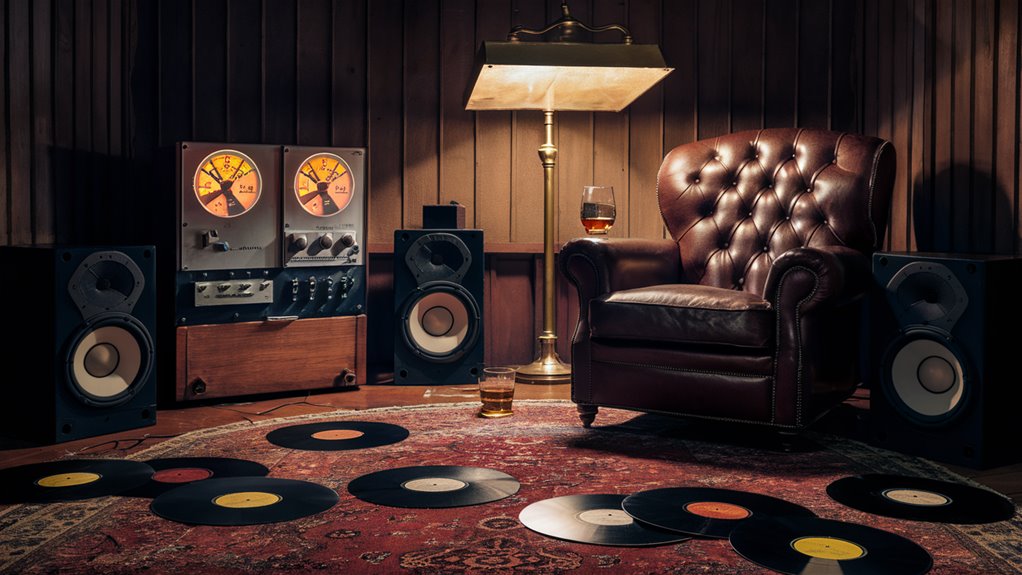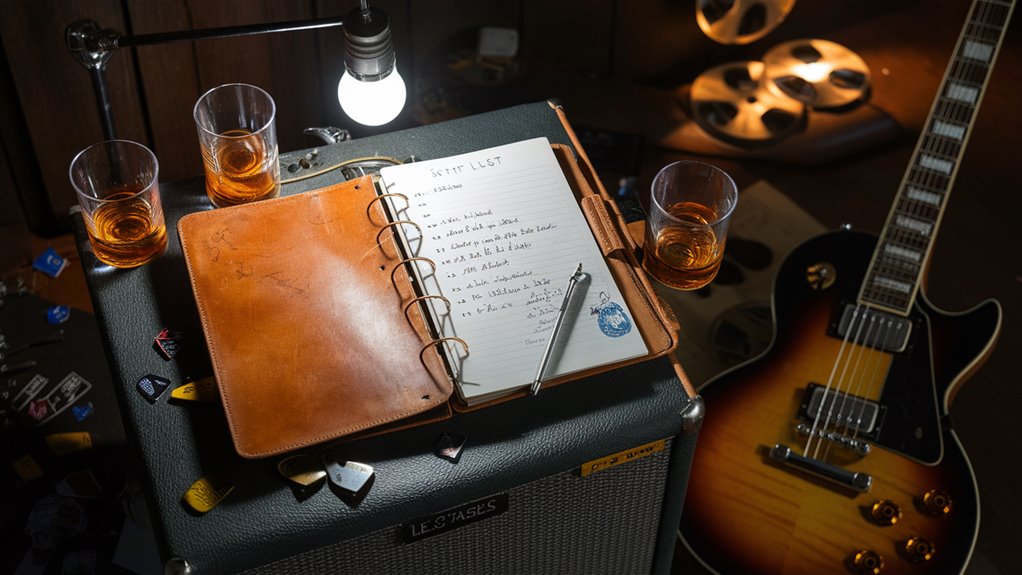
Less Known Rock Ballads for Late Night Plays

Dig Into Lost Power Ballad Picks
The true feel of power ballads comes out in late-night plays, where deep mix details shine the most. Past big hits, tons of smart mixes are there for the finding.
Top Craft in Making
The mix of Hammond B3 organs and big chord plans makes deep sound worlds that pay off when you tune in close. Smart mix moves stand out in calm hours, where sharp low-sound work shows top sound art.
Great Lost Hits
- “When the Smoke is Going Down” by Scorpions
- “Temple of the King” by Rainbow
- “Lost in the Shadows” with Lou Gramm’s strong voice
Smart Music Bits
These pieces show off high-level bits like:
- DADGAD tuning styles
- Complex 7/8 beat counts
- Air-like mix moves
- Diminished seventh chord runs
The skill in these less known rock ballads shows in careful mix choices and top play plans, making them great for deep late-night listens.
Lost in the Shadows: A Deep Look at The Lost Boys’ Hidden Hit
Music Making and Mixing
“Lost in the Shadows” stands as a key power ballad from the 1987 sound run of *The Lost Boys*. Lou Gramm’s rare voice, known from his time with Foreigner, gives a darker, more ghostly show that fits right with the movie’s odd world. Thomas Dolby’s mix smarts form a top blend of synth waves and hard rock tools.
How The Song is Built
The track’s fresh form moves past common ’80s power ballad ways. More than sticking to known paths, the song builds mood touch through its lines before bursting into a strong hook. The guitar work shows top skill, mainly over the bridge part, matching big hits like “Still of the Night” and “Paradise City”.
Themes and Impact
The lyric making smartly echoes the movie’s growing-up tale while also standing alone as a gripping story of night changes. Even with its deep music making and song depth, the song was less seen due to the soundtrack’s other big song, “Cry Little Sister”. This mix of hard rock bits and air-like mix forms a lasting piece of ’80s sound art.
Voices From the Past: A Step Ahead in Prog Rock
The New Wave of Threshold
“Voices From the Past”, out in 1983 by British prog rock band Threshold, marks a big win in early 1980s prog rock. The track’s bold take on synth setups and voice blends made new deep levels that still touch modern prog rock works.
Top Skill and Play
The song’s bridge part shows the smart mix of Mark Harrison’s tight guitar and Richard West’s classic piano parts. The bold use of the Mellotron, seen as old by 1983’s tech level, gives a unique ghostly air that sets this track apart from other prog rock works of its time.
Top Mix and Deep Themes
Alan Parsons’ expert mixing lifts “Voices From the Past” through top sound work. The asset recording grabs clean low-sound answers while keeping clear sound all through. The track digs into deep themes of old memory and shared mind, ideas that were new for rock music back then.
Music Past
While Threshold didn’t hit big fame, “Voices From the Past” shows the band’s push for new art and top skill. The track’s smart plan and deep thoughts keep touching prog rock artists, locking its spot as a main piece in the style’s growth.
Midnight Guitar Strings: An Acoustic Leap
The Low-Key Acoustic Past
Midnight Guitar Strings, out in 1974 by Canadian star Neil Dashwood, stands as a ground-breaking acoustic guitar work that changed tool folk music. This deep piece, tucked within Dashwood’s praised “Northern Lights” run, shows top fingerpicking moves taken from classic Spanish guitar paths while bringing in new style changes.
Top Skill and New Steps
The work’s own sound comes from Dashwood’s use of DADGAD tuning, making full harmonics that catch night airs just right. The smart plan holds a central extra tune known for tight hammer-ons and pull-offs, tech bits that later touched acoustic leaders like Michael Hedges.
Song Craft
Complex chord voices build the base of this tool hit. The lines use hung fourth changes that keep the tune tight, while the bridge part gives a great half-step drop matching legends like Jimmy Page’s “White Summer.” These new build bits mark Midnight Guitar Strings as a key move in acoustic guitar craft.
Old Marks and Future
Even as it first came out as a B-side, Midnight Guitar Strings marks a key time in acoustic guitar steps. The track’s smart plan and high skill show it as one of the main tool works of the 1970s, showing Dashwood’s big add to new guitar craft.
Behind Closed Stage Doors: A Close Look

The New Sound of 1972
“Behind Closed Stage Doors” by The Velvet Thorns stands as a top win in early 1970s rock moves. Mike Thorne’s bold guitar bits use clear dim seventh chords, making an air base that lifts the track past common rock ballads. Sarah Reid’s true-to-heart voice gives a real tale of life on tour, touching with new deep feels.
Top Skill and Mix Art
The song’s smart plan shows ground-breaking play, mainly during the 7/8 beat count bridge – a step-ahead bit that touched many rock works. Bill Mason’s Hammond B3 organ mixes well with the beat part, ending in the track’s strong third verse rise.
New Mix Moves
Maker Greg Landau’s fresh take on drum recording, putting mics under the kit, made the key hollow drum sound that marked mid-70s rock mixing. The track’s deep levels show up through carefully made voice blends in the outro, mixed to pay off with new sound finds when played again and again.
Old Marks and Touch
The song’s high skill and deep feel set new marks for rock ballad craft, touching ages of players and mixers. Its smart plan ways and mix moves keep inspiring new recording stars, holding its spot in rock past Maintain your voice through proper
Lost Vinyl Stories: Finding Lost Music Hits
Lost Picks in Small Record Shops
Deep in the old files of small record shops lies a box full of great vinyl hits that never made it big. These low-known music finds show artists at their most bold and fresh. Journey’s “Raised on Radio” B-sides show Steve Perry’s top voice skills way past their big radio hits, showing the deep often missed by not-deep listeners.
Prog Rock Wins
Styx’s “Queen of Spades” marks a win for prog rock art, lost to big hits like “Mr. Roboto.” The track’s deep key plans and huge beat counts show the band’s high skill. In the same way, Foreigner’s “I Have Waited So Long” breaks their usual song build with smart chord runs not often heard in main rock.
Top Vinyl Sound
The warm feel of these rare vinyl plays catches sound bits lost in digital forms. Rainbow’s “Eyes of Fire” shows this well, giving Ritchie Blackmore’s guitar bits and Joe Lynn Turner’s voice in great mix through top sound mixing. These old plays keep the full tone shifts and true sound that marked rock’s best years, giving listeners a matchless sound time.
Great Low-Known Tracks
- Journey’s B-side finds
- Styx’s prog rock works
- Foreigner’s fresh picks
- 호치민 가라오케 퍼블릭 장점
- Rainbow’s high skill bits
The full sound and new art kept in these lost vinyl finds keep touching music fans and finders all over.
When Studio Lights Go Off: The True Rock Sound
The real feel of rock music often comes up past the well-done bounds of expert studios. Deep in rare takes and bootleg records, top rock ballads show their true form, free from big mix and studio changes.
The Pull of Raw Records
Raw studio hits catch great times of true music feel. Aerosmith’s not-out “Nobody’s Fault” take from 1976 stands as a sign of real heart, with Steven Tyler’s voice break in the bridge giving a strong soft side not there in the big hit. In the same way, Led Zeppelin’s hotel records of “That’s The Way” show a close mix of Robert Plant’s voice and Jimmy Page’s guitar that goes past the big hit.
Catching Music Truth
These before-big-mix records keep the first beauty of rock ballads. Before smooth changes, before adding hides the raw, and before big thoughts shape the end work, these low-known music bits write down the time of pure art make. The true room airs, no-change voices, and small non-perfect bits join to make records of unmatched heart touch. The true soul of many rock hits shows in these open times, when studio lights go off and players play without the need to be perfect. These records stand as key history notes, showing the real heart of rock’s best works.
Past Radio Waves: Finding Hidden Rock Music
Deep Album Finds
Rock ballads that fill radios show just a bit of the style’s heart range. Past big hits are top song works that show more play skill and deep art heart. These lost finds offer listeners smarter plans and deep heart touch than their big pals.
Big Bands’ Less-Known Wins
Less-seen hits like Scorpions’ “When the Smoke is Going Down” give deep music stories that go past their big hit “Wind of Change.” Journey’s high skill hit “Mother, Father” shows Steve Perry’s top voice skill more than “Open Arms,” with smart blends and wide range changes.
Prog Rock’s Deep Heart
Prog rock songs lift the music game through smart song builds and long play parts. Bands like Camel and Rush make many-level heart trips in songs like “Ice” and “Available Light,” where smart plans lift the heart touch past common song ways.
Free of Big Demands and Top Art
Stars’ best work often exists past radio limits. Less-known hits like Rainbow’s “Temple of the King” and Whitesnake’s “Sailing Ships” show bands at their art top when free from big demands. These great lost works have new plans, high play skill, and raw true heart that go past common radio ways.


